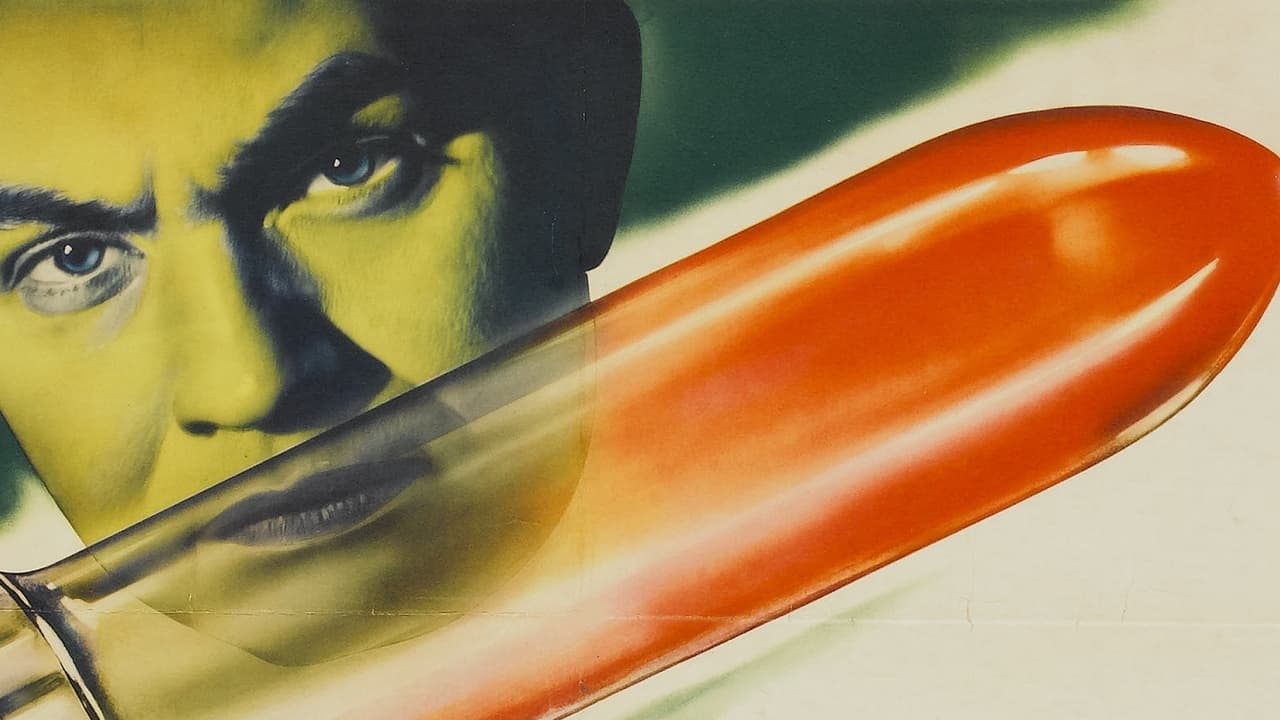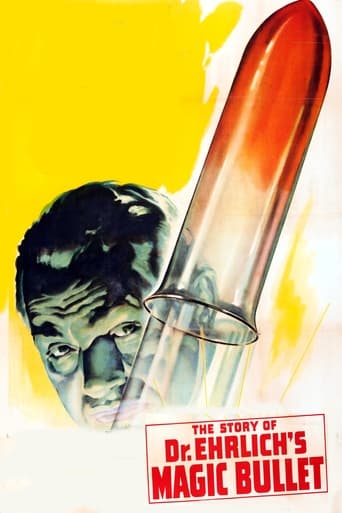

"Dr. Ehrlich's Magic Bullet" is a movie with a paradoxical goal: it wants to convince us not to be ashamed of something that the movie is obviously ashamed of.It begins with a prologue informing us of the fact that the movie is based on a true story, explaining that it was the goal of Dr. Paul Ehrlich to develop chemicals that would treat diseases, which he called "magic bullets," to treat the "scourges" of mankind. No mention is made of the particular scourge that this movie is about, which is syphilis. Already, we get the first indication of reticence on the part of the movie to actually mention the word "syphilis."In the first scene, a young man enters Ehrlich's office for a physical examination. As with the prologue, Ehrlich does not utter word "syphilis," referring to it as a contagious disease, and then, incredibly enough, adding that it is "an infection just like any other." Inasmuch as the unmentioned syphilis was, at that time, an often fatal, neurological degenerative disease, what are we to make of this inappropriately reassuring phrase, "an infection just like any other"? A clue to what he is getting at comes with the following remark, "I've seen cases where it was transmitted by an inanimate object."In other words, most people get syphilis through sexual intercourse, which makes the disease shameful. Therefore, to separate the disease from the shame, Ehrlich is making excuses for the patient's condition, indicating that he might have contracted it in some manner other than sex. Hence the phrase, "an infection just like any other." Of course, we all know that this young man probably had sex with a prostitute. So, in the very act of telling him (and us) that the disease whose name he won't utter might have been contracted in a non-shameful manner, he is implicitly saying that the vast majority of cases of syphilis, which are contracted through sex, are not infections just like any other, but are in fact something to be ashamed of.After the examination, we see Ehrlich putting some substance into a jar for the man to apply to his skin. He picks up a label, holding it between his thumb and fingers, licks the label, and applies it to the jar. Now, how's that for an inanimate object? In the very act of licking something his hands just touched right after examining the patient, he makes it hard for us to take him seriously about alternate means of transmission.He lies to his patient that some people are cured, but the man does not believe him, and while supposedly getting dressed, the patient commits suicide, apparently slitting his own throat with a scalpel. Needless to say, nothing like that ever actually happened, but exists solely for its melodramatic value. Later, Ehrlich tells his wife Hedwig that the man is better off dead, and the world is better off because he cannot infect anyone. He despairs that all the treatments he prescribes are useless, just something to give patients a false sense of hope.From this point, the movie follows Ehrlich through various medical discoveries. As is typical in movies about scientists, the role of accident is emphasized, "Eureka!" situations, as it were. Such accidents do occur in science, of course, but they are given more significance in the movies than they really deserve, because they have more dramatic value than the norm of dull, plodding science that moves from one carefully controlled experiment to another. The movie further provides us with an Arrowsmith situation, specific to medical science, in which the experiment requires that half the subjects get the serum or vaccine while the control group gets only a placebo or nothing at all; but in the name of humanity, the doctor ends up giving everyone the medicine, which saves their lives. Of course, in these dramatic situations, there is always a de facto control group anyway, which is all the people who were dropping dead from the disease prior to the experiment.In any event, about one hour in, the word "syphilis" finally makes its way into the movie. And now, what he once referred to as "an infection just like any other," he calls "man's most vicious disease." At a dinner party, when asked what he is working on, he shocks the guests by uttering the word "syphilis." Anxious to reassure the guests, he returns to the earlier dodge of saying that this disease can be transmitted by an ordinary object like a drinking cup or eating utensil. We see that Ehrlich is once again trying to remove the shame of syphilis with his reference to alternate forms of contracting the disease, which he refers to as "innocent ways." In so doing, however, he implies that there are guilty ways of contracting syphilis, which are by far the most common, such as by whoring around.Eventually, he develops Compound 606, later to be marketed as Salvarsan, a compound that allows arsenic to kill the spirochete bacterium without harming the test animals. We then get the trope of the scientist that experiments on himself, when one of Ehrlich's staff injects himself with the compound to see if it is safe for humans. Following this, we get another Arrowsmith situation, in which Ehrlich allows Compound 606 to be made available to doctors before he is through testing it, sacrificing strict scientific procedure for the sake of the dying patients. As a result, a few patients die, leading to accusations against Ehrlich, who in turn sues for libel. This is most fortunate, from a cinematic standpoint, because a trial is also a good way to dramatize science.In the end, however, Dr. Ehrlich was more successful in his struggle to defeat syphilis than the movie was in its struggle to defeat the shame that comes from contracting it.
... View MoreWell made and accurate film illustrating the great efforts Dr. Ehrlich made in strict scientific method and his ability to comprehend disparate events. This culminated in Dr. Ehrlich's nearly single-handed development of cytology, histology, hematology, hypothesis of immunity and antitoxins and cure for syphilis. Illustrates what one determined individual willing to work may accomplish to the betterment of mankind. Paul Ehrlich was a dedicated physician and scientist of the first order. His efforts likely saved the lives of some of your ancestors if not you, yourself. I regret I can not afford to buy the movie, nor find it re-listed on the TV guide or movie listings. I would be happy to see it again, though it illustrates how little I have made of my life in comparison to that of Dr. Ehrlich.
... View MoreTugs at the heart-strings. A compassion-laden film about a true-life German Doctor seeking the cure to some of the world's worst ailments, including syphilis, polio and influenza. When an epidemic hits the country, he goes about pulling out all the stops to find a so- called "magic bullet" as a veritable cure-all, and finally accomplishes his goal in pill 606, named after the number of tries to perfect this ideal drug. After some unfortunate losses in a few allergic reactions, despite his own warnings to the medical community that there still needed some tests to be done, he is vindicated and is eventually and rightfully awarded the Nobel Prize.There are some really moving and inspiring moments in the film, with the contemplation of nobility, ingenuity, and the passionate pursuit of knowledge. It is all worth it in the end when you see the faces of those formerly ill children and grown-ups beaming with healthy life again.
... View MoreDr. Ehrlich's Magic Bullet came out in 1940 a year after Paul Muni's contract with Warner Brothers ended. I'm sure this property was originally developed with him in mind. But Edward G. Robinson does an excellent job in what may have been his best screen role.Sad that this above all films was not given an Oscar Nomination for Best Actor for Mr. Robinson. He never was even nominated and was given a posthumous tribute Oscar after his death in 1973.Paul Ehrlich (1854-1915) was a pioneer scientist who discovered first the principle of staining microbes, the better to see them with under a microscope which was of inestimable value to research scientists still today. But he's best known for discovering an effective cure for syphilis.The film opens in fact with Robinson as Ehrlich breaking the bad news to a young man that he now has it. The young man kills himself and this effects Robinson. The rest of the film is spent in search of a cure for the disease which was not even mentioned in polite company.With the advent of the AIDS epidemic, scientists in the 1980s ran into the same prejudices that Ehrlich dealt with. He also labored under an additional prejudice of being Jewish. In 1940 that point was not lost on the audiences. It's a very relevant film today, brought gloriously to life by a great star and a great ensemble cast of players.
... View More